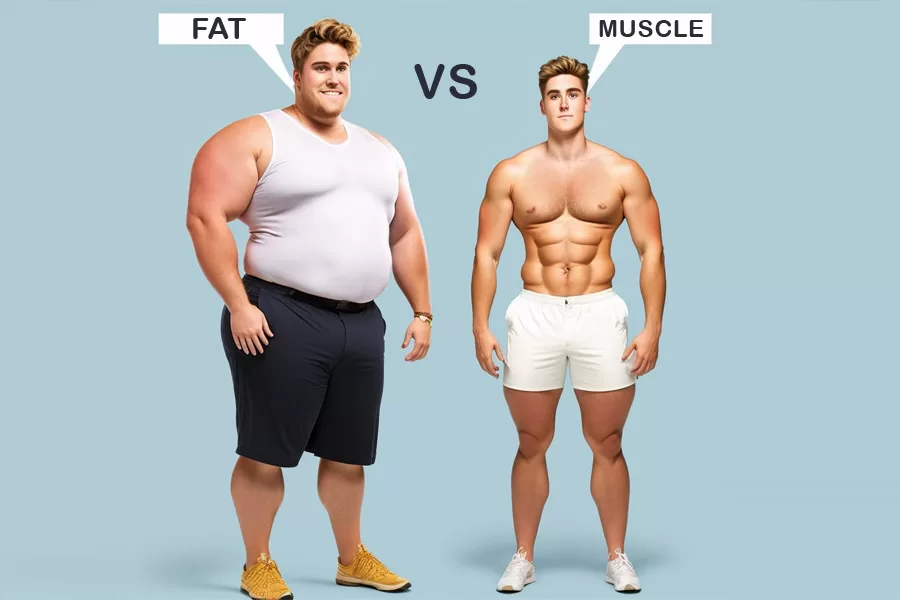The muscle-to-fat ratio of weight is a popular thing that one can often stumble upon while scrolling through Instagram fitness advice. The common statement is that muscles weigh more than fat, and it drives many takeaways about how bodies of the same weight look different and how weight gain when training means you gain muscle mass.
So, to the whole question: “is muscle heavier than fat?”. Remember an old trick of asking, what is heavier, the pound of steel or a pound of feathers? The pound of each is still a pound. Same works with our subject. So what is the difference? The answer is density. If we take muscle and fat tissue that weigh the same, the muscle piece will be much less bulky. In reverse, between pieces of the same size, the muscle one will be heavier.
Muscle vs. Fat
Are muscles heavier than fat? By volume – yes: muscles make the body taut and sculptured while fat gives it a more chubby look. Two people who have the same body mass but different muscle-fat ratios will have different clothing sizes.
Muscles, while being denser, burn calories even when the person is not active. It is called basal metabolism: the amount of energy the body needs to provide for most basic life needs, such as breathing and blood circulation. The muscles also provide support for your bones (e.g. spine) and keep you strong, so it is easier for you to perform tasks and maintain good posture and a healthy, attractive look.
Fat, commonly considered as energy storage, is much more than that. It allows us to digest many valuable nutrients, such as vitamins. It also releases leptin-a hormone that affects our appetite and is believed to have an impact on metabolism, the endocrine system, and immune response.
Body Composition
The person’s body composition affects how they look and feel, and the muscle and fat percentage is part of what determines the body composition. And here is a mind-blowing thing: for one, to feel energetic and fit into your favorite jeans, the dilemma of “does muscle or fat weigh more” is of no importance! What truly matters is a healthy and balanced muscle-fat ratio.
Importance of body composition
Why is it important to build muscle mass and keep your fat percentage under control? There are a lot of reasons:
- The body tends to lose muscle as it ages. With muscle high metabolism and strength go away, too. This is why you cannot eat as many sweet and greasy foods as you used to without gaining weight. Without a proper muscle corset, is also harder to stay active and self-sufficient when you get old.
- While muscle weighs more than fat by volume, the body with an increased muscle mass is lean, well-built, and resilient.
- Higher fat percentage is associated with a variety of health conditions, such as type 2 diabetes, arthritis, hypertension, heart diseases, etc.
- Fat affects your hormones and hunger, so it is important to maintain a healthy fat percentage to enjoy a naturally balanced metabolism and feel saturated with a healthy meal.
Methods of measuring body composition
Can you assess your body composition by yourself and develop nutrition and workout plans? You surely do! Here is a list of what you can use:
- BMI. Body-mass index is the ratio of your weight and height. While it is simple to evaluate (there are many online calculators, including the one on the CDC website), it only takes into account those two parameters without considering frame size and muscle percentage. This is why it can label perfectly healthy people as overweight while in reality, they are just really muscular. So, it would be wise to use BMI in a combination with other methods.
- Bioimpedance scales. Those are smart tools that can be easily bought online or in an electronic shop. While measuring your weight, they also use minor current discharges that travel differently through the different tissues. Using those data, the scales are able to determine your fat percentage. Scales are simple to use and harmless; they also give you a good general image of your body state.
- Body fat calipers is a tool that looks like tweezers. To use it, you should pinch a tissue fold in a certain place of the body and then calculate the body fat with a special formula or an online calculator. Note that fitness specialists are more used to measuring with those; it could be smart to ask for help to not make any mistakes.
- Look a the mirror. Yes, you read that right: a simple check on your reflection, either clothed or naked, can give you a glimpse of what your body may need.
Ideal body composition
So, what fat percentage is preferable for people of different sex and age? The American Journal of Clinical Nutrition and Beth Israel Lahey Health Winchester Hospital provide us with the following numbers:
For women:
- Age 20 to 39: 21-32%
- 40-59: 23-33%
- 60-79:24-35%
For men:
- Age 20 to 39: 8-19%
- 40-59: 11-21%
- 60-79: 13-24%
Losing Fat and Gaining Muscle
As you can see, the weight of the body is not the main thing that determines your look and well-being. Training and eating goals can be summarized as “stay healthy and energetic, get enough nutrients, build muscle, and shed excess fat”. How do you do that?
Strategies
First thing, your diet. Getting help from a qualified nutritionist can make balancing that a lot easier. They will ensure that your nutrition:
- Is coherent with your goals;
- Leaves room for joy (there is nothing wrong with an occasional hot dog or an ice cream: we want to be both happy and healthy, and those are not mutually exclusive);
- Provides enough energy to perform in the gym and do your tasks;
- Has an adequate calorie deficit if you need to burn some fat.
The other thing is training. You can also use the help of a good coach for this. Take a closer look at strength training to build muscle mass in a shorter amount of time.
Common misconceptions
You do not need to starve and feel hungry all the time: in fact, that is a thing you would want to avoid. Eating healthily combined with strength training twice a week, some activities at home (like squats and pushups), and active leisure will get you there. Losing weight fast is not such a good thing as those restrictive diets tell you, but a way to get metabolism disorders: give your body time to adjust to a new routine.
Tips
In this section of our article, we will give you some tips to make the process less stressful:
- Make training and healthy eating a habit. Consistency is key to reaching your goals. Tiring yourself in the gym to death once a year or spending a day with a single apple is not.
- Do not look at those scales. Body mass tells you little to nothing about your results but can frustrate you and induce anxiety. Set some roadmap with checkpoints and keep doing good work.
- Work with fitness and healthcare professionals. They will ensure that your path is safe and help you avoid beginner’s mistakes.
- Keep it fresh and interesting for you. Find the physical activity you enjoy. Try new dishes. This will help you stay in a healthy routine.
Summary
Does fat weigh more than muscle? The same volume of fat weighs less; however, it is important to keep a low fat percentage and good muscle mass to be fit and healthy.
FAQ
Can I weigh more because of muscle?
Yes, muscles are dense which is why lean people can have weight close to chubby ones.
How much more does muscle weigh than fat?
It depends on tissue volumes here. Muscles are ~1.17 times denser than fat, but the pound of each weighs exactly a pound.
Why do I look fat but weigh less?
Fat has a lower density than muscles: the quantity with the same or even less mass will be bulkier.
How do you tell if it’s muscle or fat?
A look in the mirror can solve the dilemma, or you can follow the changes with smart scales.







